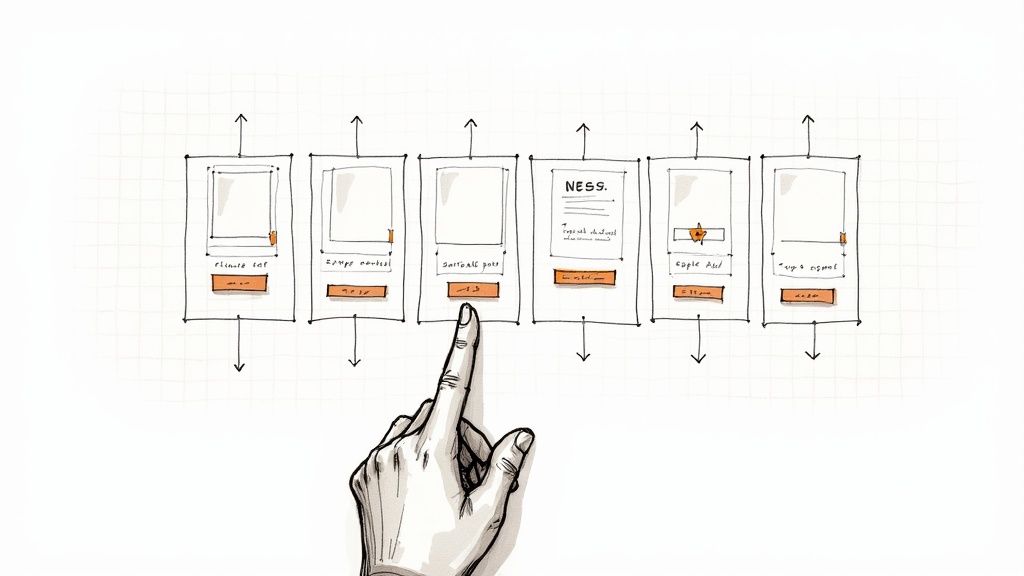
7 Interactive Ads Examples Dominating Engagement in 2025
In today's saturated digital landscape, passive viewing is a relic of the past. Attention is the new currency, and brands are fighting harder than ever to earn it. This is where interactive advertising transforms the game, moving audiences from passive observers to active participants.
Unlike traditional static or linear video ads that broadcast a one-way message, interactive ads invite a dialogue. They pull users into the experience, encouraging them to play, choose, explore, and shop directly within the ad unit. This fundamental shift doesn't just boost engagement metrics; it builds deeper brand connections, generates valuable first-party data, and significantly shortens the path to conversion. As many of these formats use dynamic visuals, understanding the principles of mastering video marketing for social media is essential for maximizing their impact and ROI.
This article will deconstruct seven powerful interactive ads examples, revealing the strategic thinking behind their success. We will go beyond the surface to analyze the specific mechanics, psychological triggers, and actionable tactics that you can adapt for your own campaigns. Prepare to see how the most innovative brands are not just capturing attention, but commanding it through formats like shoppable video, playable ads, AR try-ons, and more.
1. Shoppable Video Ads
Shoppable video ads transform passive viewing into an active shopping experience. These innovative formats allow consumers to click on products directly within a video, explore details, and even make a purchase without ever leaving the player. This seamless integration closes the gap between discovery and conversion, a critical advantage in today's fast-paced digital marketplace.
Platforms like Instagram, YouTube, and TikTok have pioneered this format. A fashion brand, for instance, can showcase a new collection in an Instagram Story video, and viewers can tap on a specific dress to see its price and purchase it. Similarly, a beauty influencer’s YouTube tutorial can feature clickable product shelves below the video, linking directly to the makeup used. These types of interactive ads examples are powerful because they capture purchase intent at the peak of consumer interest.
Strategic Analysis: Why It Works
The core strength of shoppable video is its ability to reduce friction in the customer journey. By embedding the point of sale directly into engaging video content, brands can capitalize on the "I want it now" impulse. This approach maintains narrative flow while providing immediate gratification.
Key Strategic Insight: Shoppable video ads merge the emotional appeal of storytelling with the transactional efficiency of e-commerce. They turn inspiration into an immediate, actionable opportunity, significantly shortening the path to purchase.
Actionable Takeaways & Best Practices
To effectively implement shoppable video ads, focus on a seamless user experience.
- Subtle Hotspots: Integrate clickable product tags that are visible but not disruptive to the viewing experience.
- High-Quality Visuals: Use clear, high-resolution product images within the clickable pop-ups to build trust and showcase quality.
- Optimal Timing: Test when to introduce interactive elements. Presenting them after a key moment of interest can increase engagement.
- Mobile-First Design: Ensure all interactive elements are optimized for touchscreens, with easily tappable buttons and intuitive navigation.
To provide a quick reference on their effectiveness, here are some key performance metrics for shoppable video ads.
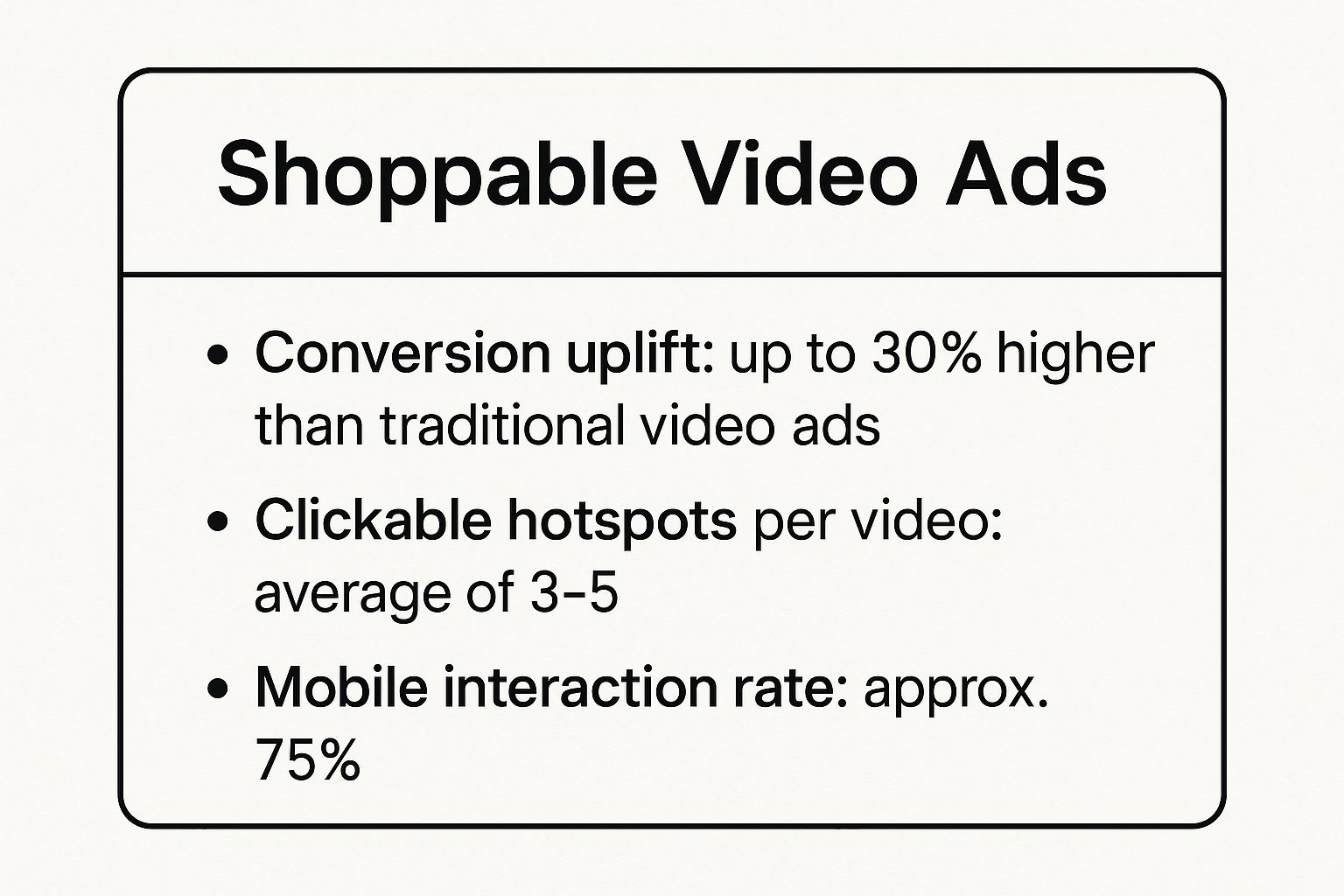
The data clearly shows that shoppable videos not only drive conversions but are also highly engaging, particularly on mobile devices where most social video is consumed. For a deeper dive, you can explore more detailed guides on how to create compelling shoppable video ads.
2. Augmented Reality (AR) Try-On Ads
Augmented Reality (AR) try-on ads superimpose digital products onto a user's real-world environment through their device's camera. This technology bridges the gap between online browsing and physical trial, allowing consumers to virtually "wear" items like makeup, glasses, or sneakers from anywhere. By creating a personal and immersive preview, AR ads help overcome a major hurdle in e-commerce: purchase uncertainty.
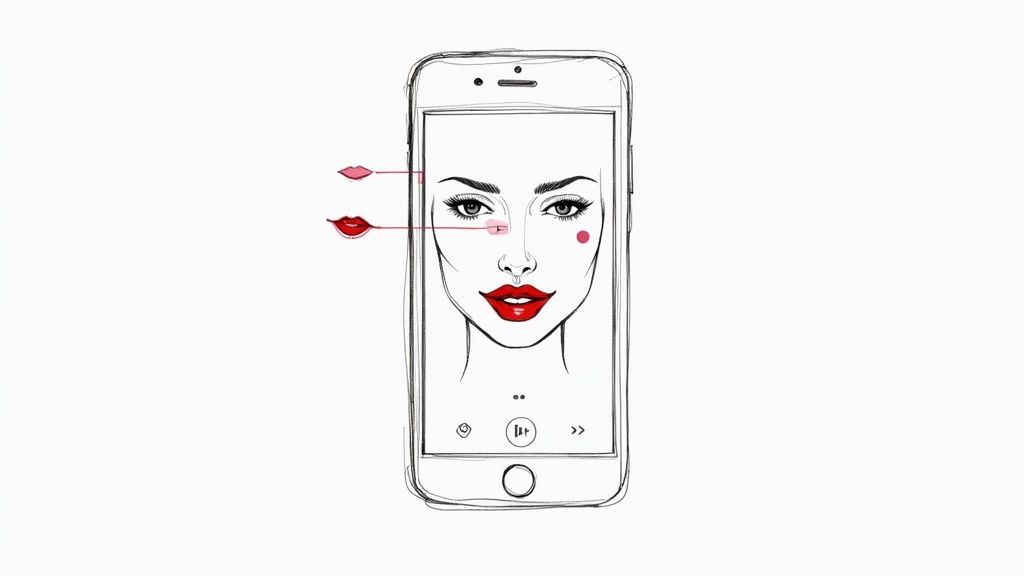
Brands like Sephora with its Virtual Artist feature and Warby Parker with its virtual glasses fitting are prominent examples of this technology in action. Users can open their camera within an ad or app, see how a specific lipstick shade looks on them, or determine if a style of eyeglass frame suits their face shape. These types of interactive ads examples are exceptionally effective because they offer a functional utility that directly aids the decision-making process, boosting confidence and reducing the likelihood of returns.
Strategic Analysis: Why It Works
The power of AR try-on ads lies in their ability to deliver a personalized, high-value experience that solves a customer pain point. Instead of guessing how a product will look, consumers can see it for themselves, transforming a passive ad into a practical tool. This creates a powerful connection with the product and brand, moving beyond simple awareness to genuine consideration.
Key Strategic Insight: AR try-on ads demystify the online shopping experience by offering a tangible preview. They increase purchase confidence and decrease return rates by blending the convenience of digital with the assurance of a physical try-on.
Actionable Takeaways & Best Practices
To launch a successful AR try-on campaign, focus on realism and user-friendliness.
- Accurate Representation: Ensure product colors, textures, and sizes are rendered as accurately as possible to manage customer expectations.
- Optimize for Lighting: The technology should perform well under various lighting conditions, from dim indoor light to bright outdoor sun.
- Clear Instructions: Guide users with simple on-screen prompts on how to position their face or body for the best results.
- Incorporate Social Sharing: Add a feature that allows users to easily share a photo or video of their virtual try-on, turning users into brand advocates.
3. Playable Game Ads
Playable game ads offer a "try-before-you-buy" experience for mobile applications, primarily games. They function as micro-demos, allowing users to engage with a core gameplay mechanic directly within the ad unit itself. Instead of passively watching a video trailer, users get a hands-on preview, creating an instant connection to the app's experience.
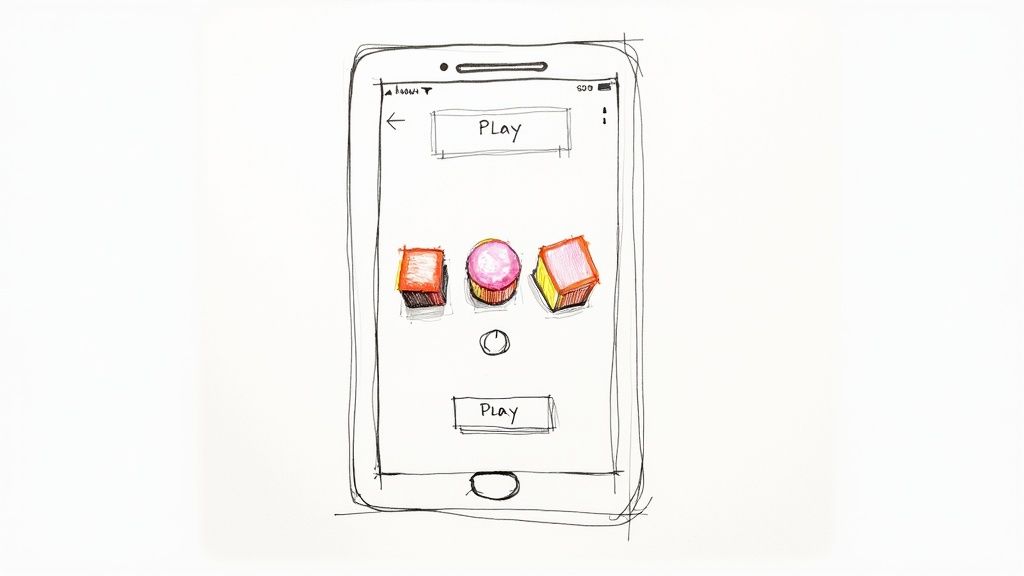
This format is famously used by mobile game giants like King and Playrix. Ads for Candy Crush Saga often feature a simplified match-three puzzle, while Gardenscapes might present a single, engaging puzzle-solving challenge. These interactive ads examples are designed to give users a taste of the satisfaction the full game provides, making the call to download much more compelling.
Strategic Analysis: Why It Works
The effectiveness of playable ads lies in their ability to pre-qualify users and reduce install friction. By letting users experience the core loop of the game, advertisers attract players who are genuinely interested in the gameplay, leading to higher retention rates and lifetime value. It filters out users who would otherwise install and quickly churn after discovering the game isn't for them.
Key Strategic Insight: Playable ads convert passive viewers into active participants, leveraging the psychology of intrinsic motivation. A small taste of success within the ad creates a powerful desire to experience more, driving high-intent installs.
Actionable Takeaways & Best Practices
To create effective playable ads, prioritize a low-friction, high-reward experience.
- Focus on Core Mechanics: Isolate the single most satisfying action in your game, such as solving a puzzle or achieving a small victory, and build the demo around it.
- Keep It Short: Aim for a 15-30 second gameplay session that quickly demonstrates the fun without becoming tedious or complex.
- Clear Call-to-Action: Prompt the user to download the full app at a natural stopping point, such as after they've successfully completed the mini-game.
- A/B Test Difficulty: Experiment with different levels of challenge. An experience that is too easy can be boring, while one that is too hard can be frustrating. Find the sweet spot that maximizes engagement and conversions.
4. Interactive Video Polls and Quizzes
Interactive video polls and quizzes transform traditional ad viewing into a dynamic, two-way conversation. These formats embed questions, polls, or choice-based scenarios directly into the video, prompting viewers to participate in real time. This active engagement not only holds attention but also allows brands to gather valuable, first-party data on consumer preferences, knowledge, and interests.
Platforms like YouTube and specialized video tools have popularized these ads. For example, a food delivery service like McDonald's might run an ad asking viewers to vote for their favorite menu item, while a media company like BuzzFeed can use a personality quiz within a video to recommend content. These interactive ads examples are exceptionally effective because they make the viewer part of the story, turning passive consumption into an engaging, personalized experience.
Strategic Analysis: Why It Works
The power of interactive polls and quizzes lies in their ability to leverage natural human curiosity and the desire for self-expression. By asking for an opinion or testing knowledge, brands create a "lean-in" moment where the viewer becomes an active participant rather than a passive observer. This interaction deepens brand recall and provides a clear data trail for future personalization.
Key Strategic Insight: Interactive polls and quizzes turn advertisements into a mechanism for customer research and personalized engagement. They generate direct feedback while making the viewer feel heard and valued, fostering a stronger brand connection.
Actionable Takeaways & Best Practices
To successfully deploy interactive video polls and quizzes, prioritize relevance and a smooth user experience.
- Keep Questions Relevant: Ensure every question or poll directly relates to your brand, product, or the video's core message to maintain context.
- Provide Personalized Outcomes: Use quiz results to offer tailored recommendations, content, or product suggestions, making the interaction meaningful for the user.
- Optimize for Mobile: Design large, easily tappable buttons and clear, concise text to ensure a flawless experience on all screen sizes.
- Strategic Placement: Test different timings for your interactive elements. Placing a poll after a key emotional moment or a quiz before a reveal can significantly boost participation.
By integrating these elements, you can create compelling interactive experiences. For brands looking to build more complex narratives, understanding how choices can create different user paths is crucial. You can explore a more detailed breakdown of how to build these experiences through interactive video branching.
5. 360-Degree Product Exploration Ads
360-degree product exploration ads replicate the tangible experience of examining a product in-store, allowing users to rotate, zoom, and inspect items from every angle. This format uses a series of high-resolution images or 3D models to give consumers complete control over their viewing experience, bridging the gap between digital browsing and physical interaction.
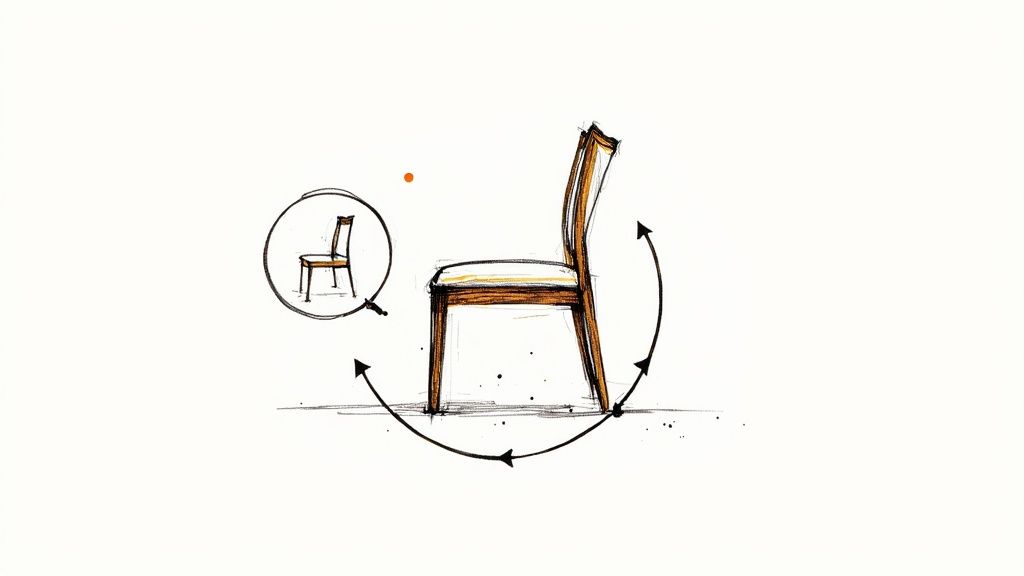
Brands like IKEA and BMW have successfully used this technology to showcase complex products like furniture and vehicles. A customer can explore the interior of a car or see how a sofa looks from the back without leaving the ad. These types of interactive ads examples build consumer confidence by providing a transparent and detailed product view, which is crucial for high-consideration purchases. Apple also uses this to let users examine the fine details and craftsmanship of its devices.
Strategic Analysis: Why It Works
The effectiveness of 360-degree ads lies in their ability to answer detailed product questions visually, reducing purchase anxiety. By letting users take control, brands empower them to verify quality, check features, and understand a product's form and function on their own terms. This active engagement fosters a deeper connection and increases the user's perceived ownership of the item.
Key Strategic Insight: 360-degree ads transform passive observation into active discovery. They satisfy the customer's need for information and control, which directly increases trust and significantly boosts conversion rates for e-commerce products.
Actionable Takeaways & Best Practices
To create effective 360-degree product ads, prioritize an intuitive and informative user experience.
- Invest in Quality Imagery: Use professional, high-resolution 360-degree photography or photorealistic 3D models to ensure a premium feel.
- Optimize for Speed: Compress image files without sacrificing quality to guarantee fast load times, preventing user drop-off.
- Integrate Information Hotspots: Add clickable points that reveal key features, material details, or dimensions as the user explores. Explore how hotspots in e-commerce can boost sales for more ideas.
- Ensure Mobile Fluidity: Design the experience with touch controls in mind, ensuring smooth rotation and responsive zooming on all devices.
6. Social Media Story Interactive Stickers
Social media story interactive stickers transform ephemeral content into a powerful tool for two-way communication. These native features, embedded directly within platforms like Instagram and Facebook Stories, allow brands to engage their audience through polls, quizzes, sliders, and question boxes. Instead of passively consuming content, users are invited to share their opinions, test their knowledge, and provide direct feedback.
For instance, a brand like Airbnb can use a question sticker to ask, "What's your dream travel destination?" and then feature user responses in subsequent stories. Similarly, Starbucks frequently uses polls to let followers vote on their favorite seasonal drinks, creating buzz and a sense of community. These types of interactive ads examples are effective because they leverage existing user behaviors within a familiar, low-friction environment, turning a simple story view into a meaningful brand interaction.
Strategic Analysis: Why It Works
The primary strength of interactive stickers lies in their ability to foster a sense of participation and co-creation. By asking for an opinion or feedback, brands make their audience feel heard and valued, which deepens brand affinity. This micro-engagement is simple for the user, often just a single tap, yet provides the brand with valuable, real-time audience insights.
Key Strategic Insight: Interactive stickers gamify engagement and generate authentic, user-driven content. They tap into the human desire for self-expression and community, converting passive viewers into active participants in the brand's narrative.
Actionable Takeaways & Best Practices
To maximize the impact of interactive stickers, focus on creating genuine, engaging conversations.
- Ask for Direct Feedback: Use question stickers to gather customer feedback on products, services, or potential new ideas.
- Create Urgency with Polls: Run limited-time polls related to product launches or promotions to drive immediate engagement and a sense of exclusivity.
- Leverage User-Generated Content: Showcase the best responses from question stickers or quizzes in follow-up content, making your audience the hero.
- Maintain Brand Voice: Ensure your questions and poll options are consistent with your brand's personality, whether it's playful, informative, or aspirational.
These simple tools offer a direct line to your audience's preferences and can significantly boost engagement metrics with minimal production effort.
7. Interactive Display Banners with Expandable Content
Interactive display banners with expandable content reimagine the standard banner ad, transforming it from a static image into a dynamic mini-experience. These ads entice users to engage by expanding to reveal more information, videos, or even games when a user hovers or clicks, all without navigating away from the original webpage. This format maximizes the value of traditional ad real estate by packing more content into a compact initial state.
For instance, an automaker like Toyota could deploy a banner that, upon interaction, expands to reveal a mini car configurator allowing users to change colors and trims. Similarly, a Booking.com ad could expand to show a gallery of hotel images and available dates. These types of interactive ads examples are effective because they respect the user's browsing context while offering a deeper, voluntary brand engagement that feels less intrusive and more rewarding.
Strategic Analysis: Why It Works
The strength of expandable banners lies in their ability to deliver a rich media experience within a standard ad unit, balancing visibility with user control. They capture attention without immediately disrupting the user’s journey, offering an invitation to explore rather than a demand for a click-through. This layered approach respects user autonomy, which often leads to higher quality engagement.
Key Strategic Insight: Expandable display banners act as a gateway to deeper content, satisfying user curiosity on-demand. They merge the broad reach of programmatic display with the immersive quality of a rich media landing page, boosting engagement and brand recall.
Actionable Takeaways & Best Practices
To create successful expandable banners, prioritize a clean user flow and compelling creative.
- Enticing Initial State: The collapsed banner must be visually appealing and include a clear call-to-action (like "Hover to Expand" or "Click for More") to encourage interaction.
- Fast Loading: The expanded content must load almost instantly. Any lag will cause users to abandon the interaction before it even begins.
- Clear Exit Path: Always include a prominent and easily clickable "Close" button. This gives users control and prevents them from feeling trapped in the ad.
- Cross-Device Testing: Ensure the expand and collapse functionality works seamlessly across all major browsers and devices, especially on mobile where screen space is limited.
Platforms like Google Web Designer and Sizmek have made it easier than ever for brands to build and deploy these sophisticated ad units at scale.
7 Interactive Ad Formats Comparison
Your Next Move: Turning Interactive Insights into Action
Throughout this exploration of interactive ads examples, a powerful, unifying theme has emerged: the most successful brands are no longer just broadcasting messages, they are initiating conversations. We’ve seen how shoppable video ads from brands like Ted Baker collapse the sales funnel, how L’Oréal's AR try-ons solve a genuine customer problem while creating viral moments, and how playable ads for games like Royal Match tap into our innate desire for challenge and reward. The era of passive consumption is definitively over.
The future of digital advertising isn't about simply showing your product or service; it's about inviting your audience to experience it. From the immersive exploration offered by 360-degree product ads to the simple, yet effective, engagement of Instagram Story polls, the common denominator is a fundamental respect for the user's time and intelligence. Instead of interrupting their journey, these ads become a valuable, and often enjoyable, part of it. This strategic shift moves the consumer from being a passive recipient to an active participant in your brand's story.
Synthesizing Key Strategies for Success
As you plan your next campaign, the diverse examples we've analyzed provide a clear roadmap. The crucial first step is to align the ad format directly with your primary business objective.
- To Shorten the Path to Purchase: Implement shoppable video ads. By making your video content clickable and transactional, you remove friction and capture intent at its peak.
- To Generate Viral Buzz & Solve Pain Points: Leverage AR try-on ads. This format offers immense utility, builds confidence, and creates highly shareable user-generated content.
- To Capture Rich Customer Data: Deploy interactive polls and quizzes. These are invaluable for gathering first-party data on preferences, needs, and knowledge gaps, enabling deeper personalization.
- To Drive High-Quality Leads: Utilize playable ads. They act as a powerful qualification tool, attracting users who are genuinely interested in the core mechanic of your app or service.
To fully capitalize on the engagement generated by these interactive elements, a comprehensive understanding of broader strategies for successful PPC campaign optimization is essential. A well-optimized campaign ensures that the qualified traffic you attract from an interactive ad is channeled effectively through the rest of your conversion funnel.
Your Actionable Blueprint
The most important takeaway from these powerful interactive ads examples is that you can start now. The technology is more accessible than ever, but success hinges on a thoughtful, user-centric approach. Begin by focusing on one format that aligns with a key business goal. Test it on a smaller scale, obsess over the user experience, and meticulously measure the results against your baseline metrics.
By embracing an interactive mindset, you are investing in more than just a fleeting campaign. You are building a foundation for more meaningful, memorable, and ultimately more profitable relationships with your customers. The goal is to create advertising so engaging and useful that your audience genuinely wants to interact with it.
Ready to transform your passive video content into an engaging, lead-generating machine? With Mindstamp, you can easily add clickable buttons, personalized questions, and powerful branching logic to any video. Explore the interactive ad examples for yourself and start building your first interactive experience today.
Get Started Now
Mindstamp is easy to use, incredibly capable, and supported by an amazing team. Join us!



Try Mindstamp Free










